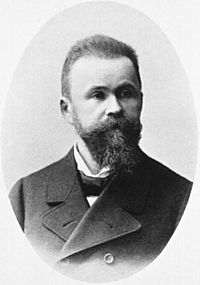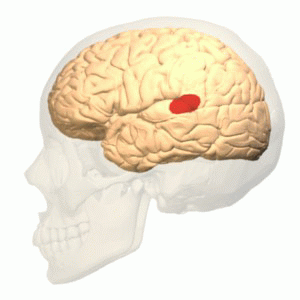Carl Wernicke facts for kids
Quick facts for kids
Carl Wernicke
|
|
|---|---|
 |
|
| Born | 15 May 1848 Tarnowitz, Upper Silesia, Kingdom of Prussia
|
| Died | 15 June 1905 (aged 57) Gräfenroda, German Empire
|
| Alma mater | University of Breslau |
| Known for | Wernicke aphasia, Wernicke–Korsakoff syndrome |
| Scientific career | |
| Fields | Psychiatry, neurology |
| Institutions | Charité, University of Breslau, University of Halle |
| Influences | Theodor Meynert |
Carl Wernicke (born May 15, 1848 – died June 15, 1905) was an important German doctor. He studied the brain and how it affects our minds and bodies. Wernicke is famous for his work on certain brain diseases and on a condition called receptive aphasia. This condition makes it hard for people to understand language.
Both of these are often named after him: Wernicke encephalopathy and Wernicke's aphasia. His research, along with that of another scientist named Paul Broca, helped us understand that different parts of the brain have special jobs. For example, specific areas control speech. Because of his discoveries, a part of the brain important for understanding language is called Wernicke's area.
Contents
Carl Wernicke's Life Story
Carl Wernicke was born on May 15, 1848. His hometown was Tarnowitz, which is now called Tarnowskie Góry in Poland. He went to school in Oppeln, near the University of Breslau. Later, he studied medicine at the University of Breslau. He focused on language and aphasia during his studies in Breslau, Berlin, and Vienna.
After becoming a doctor in 1870, he worked at a hospital in Breslau. He was an assistant to an eye doctor for six months. In 1870, the Franco-Prussian War started, and Wernicke served as an army surgeon. After the war, he returned to the hospital. He worked in the mental health department. His professor sent him to Vienna to learn from Theodor Meynert, a brain specialist. This trip greatly influenced Wernicke's future work.
In 1875, Wernicke became the first assistant at a clinic in Berlin. He stayed there until 1878, studying mental and nervous diseases. In 1878, Wernicke started his own private practice in Berlin. He wrote many articles during this time.
In 1885, he became a professor at Breslau University. He taught about brain and mental health. By 1890, Wernicke was in charge of the mental health wing at a hospital. He also led the University Hospital's Department of Neurology and Psychiatry. In 1904, Wernicke moved to the University of Halle. There, he directed the Psychiatry and Neurology Clinic.
Carl Wernicke died on June 15, 1905. He passed away from injuries he got in a bicycle accident. This happened in the Thuringian Forest.
How Wernicke Studied Language Problems
Wernicke was very interested in the research on language. This research came from Paris, France, especially from Paul Pierre Broca. Broca had studied motor aphasia, which is when people have trouble speaking. This made Wernicke want to learn more about how brain damage affects language. He wondered if different language problems came from damage in specific brain areas.
In 1874, Wernicke published a book called Der Aphasische Symptomencomplex. In this book, he described sensory aphasia. Today, we call it Wernicke's aphasia. He said it was different from the motor aphasia Broca described. Wernicke explained that sensory aphasia means someone can speak fluently, but their speech is often jumbled. They also have trouble understanding what others say or reading silently.
Wernicke combined his findings with Broca's. He believed both types of aphasia were caused by brain damage. But the location of the damage decided which type of aphasia a person would have. He said sensory aphasia came from damage to the left temporal lobe of the brain. Broca's aphasia came from damage to the left front part of the brain. These ideas formed the basis of his theory on how language works in the brain.
Wernicke thought that movement and feeling were connected in the brain. He believed there were fibers connecting the parts of the brain for movement and feeling. So, he thought there must be a connection between the areas causing sensory and motor aphasia. If this connection was broken, a person might still understand speech but couldn't turn their thoughts into clear words.
Wernicke also warned doctors not to confuse sensory aphasia with other mental states. He stressed the importance of telling the difference between aphasia and agnosia. Agnosia is when someone can't recognize objects, even though their senses are working.
Wernicke's ideas helped develop the theory of localization. This theory suggests that different, specific parts of the brain control different actions and behaviors. These areas then work together to create more complex behaviors, like language. Broca's and Wernicke's work opened the door for other scientists. They could then study and find other specific brain areas. This led to understanding how brain damage in certain areas causes different disorders and behaviors.
Another doctor, Ludwig Lichtheim, was influenced by Wernicke's work. Lichtheim studied language abilities and sorted language problems into seven types of aphasia. Wernicke's aphasia was one of them. Wernicke later used Lichtheim's way of classifying aphasia. This became known as the Wernicke-Lichtheim model.
Conditions Named After Wernicke
- Wernicke's aphasia: This is a problem where people have trouble understanding speech. They also find it hard to produce speech that makes sense. It's caused by damage to a specific part of the brain called the posterior superior temporal gyrus.
- Wernicke encephalopathy: This is a serious brain problem. It happens when someone doesn't have enough thiamine (Vitamin B1). It often causes eye movement problems, trouble with balance, and confusion. If it happens along with another memory problem called Korsakoff psychosis, it's called Wernicke–Korsakoff syndrome.
- Wernicke's pupillary reaction: This describes when a part of the eye that is blind doesn't react to light.
- Wernicke's centre
- Wernicke's cramp
- Wernicke's dementia
- Wernicke's disease
- Wernicke-Korsakoff disease
- Wernicke-Mann hemiplegia
See also
 In Spanish: Carl Wernicke para niños
In Spanish: Carl Wernicke para niños


